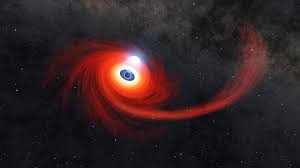Two pairs of gigantic black holes, each in a different dwarf galaxy, are speeding towards each other, and they’re set for two separate, never-before-seen collisions.
Astronomers used NASA’s Chandra X-ray Observatory to spot the four dwarf galaxy black holes racing towards each other, dragging an enormous train of gas and stars in their wake. Some of this material is already being sucked into the black holes, causing them to grow ever larger before their eventual crashes.
Read More:-Google Glass is set to disappear (again)
The first pair was spotted in the galaxy cluster Abell 133, located 760 million light-years from Earth, and the other was seen in the Abell 1758S galaxy cluster, roughly 3.2 billion light-years away. They are set to collide and merge to form even larger galaxies, and studying them as they approach each other could help astronomers understand how the cosmic monsters lurking across the universe came to grow so large. The findings were published Nov. 8 on the preprint database arXiv, and they have been accepted for publication in The Astrophysical Journal.
“We’ve identified the first two different pairs of black holes in colliding dwarf galaxies,” co-author Olivia Holmes, a physics student at the University of Alabama at Tuscaloosa, said in a statement. “Using these systems as analogs for ones in the early universe, we can drill down into questions about the first galaxies, their black holes, and star formation the collisions caused.”
Read More:- Samsung Galaxy S23 FE launch timeline tipped, could feature Qualcomm Snapdragon 8 Gen 1 SoC
Black holes are born from the collapse of giant stars and grow by ceaselessly gorging on gas, dust, stars and other other black holes in the star-forming galaxies that contain them. Where the first black holes came from is a question that has long puzzled scientists.
Past simulations of the “cosmic dawn” — the epoch encompassing the first billion years of the universe — have suggested that billowing clouds of cold gas may have coalesced into giant stars that were doomed to rapidly collapse, creating black holes. As these black holes grew larger, the ever-growing trains of gas surrounding them collapsed into stars — eventually forming dwarf galaxies.
Also Read- Samsung Phones’ Moon Photos Might Be Too Good to Be True
Astronomers theorize that as the universe grew, the first dwarf galaxy black holes quickly merged with others to seed even bigger supermassive black holes — and with them bigger galaxies — throughout the cosmos. But, until now, no such mergers between black holes inside dwarf galaxies had been observed.
To search for these elusive black hole mergers, the researchers conducted a survey of Chandra X-ray observations before comparing them with data collected in infrared frequencies by NASA’s Wide Infrared Survey Explorer (WISE) and in optical frequencies by the Canada-France-Hawaii Telescope (CFHT). As the gas orbiting black holes’ maws can get heated to millions of degrees, the researchers used Chandra to look for pairs of galaxies beaming out high-energy X-rays. Sure enough, they found not just one but two pairs.
Read More:- How to directly sync Apple Watch workouts to Strava
The astronomers observed that the first pair, in Abell 133, was already in the later stages of a merger, and gravitational tidal effects have stretched out a long tail of material around the two black holes that the researchers named “Mirabilis” after an endangered species of long-tailed hummingbird. The two black holes located in Abell 1758S — dubbed “Elstir” and “Vinteuil,” after fictional artists from Marcel Proust’s “In Search of Lost Time” — are in the early stages of a merger and are connected by a giant bridge of stars and gas that has stretched out between them.
The researchers say that studying the dwarf galaxies further could offer some vital clues into how the Milky Way’s supermassive black hole came to grow from a tiny black hole seedling to its present gargantuan size.
Read More:-Silicon Valley elites are warring over who does ‘fake work’ in tech
“Most of the dwarf galaxies and black holes in the early universe are likely to have grown much larger by now, thanks to repeated mergers,” co-author Brenna Wells, a physics student at the University of Alabama at Tuscaloosa, said in the statement. “In some ways, dwarf galaxies are our galactic ancestors, which have evolved over billions of years to produce large galaxies like our own Milky Way.”





































